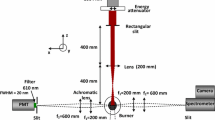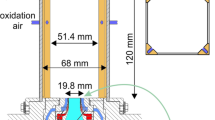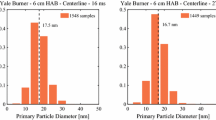Abstract
An original in situ experimental approach is proposed to estimate the absorption function of soot particles in flames: the two separated pulses laser-induced incandescence technique (SP-LII). The SP-LII technique is based on measuring the peak temperature of soot particles heated by laser pulses at two different fluences. From these two temperature measurements, the absorption function is estimated by solving the energy equation applied to soot particles during laser energy absorption once the product of soot density and specific heat is known. In order to solve the energy equation, two methods are considered here. The first method, called the “absorption model” (AM), solves the energy equation when all loss terms are neglected during absorption. The second method uses a look-up table (LUT) generated with an LII code in which the main loss terms are modelled. Both methods also provide information on the gas temperature \(T_0\), assuming that gas and solid phases are at equilibrium. First, the SP-LII technique’s accuracy and limits are theoretically explored using peak temperatures from simulations done with an LII code. Overall, the AM method is efficient but is restricted to soot primary particles diameter \(> \sim 10\) nm and low fluences. By contrast, the LUT method has an extended operational range, but it requires more information than the AM method, and its accuracy depends on the validity of the power loss models used to generate the look-up table. It is then concluded that the AM method represents the best compromise between the complexity of the methods and the expected accuracy of the results. Then, the feasibility of the SP-LII technique is proven by performing measurements in a laminar diffusion methane/air sooting flame and post-processing them with the AM method. Results for the absolute value and for the spatial evolution of \({E(m_{\lambda} )}\) are coherent with the literature. Finally, a possible extension of the SP-LII technique to turbulent flames is discussed.


















Similar content being viewed by others
Data availability
The experimental data are included in the supplementary information files.
References
T.R. Barfknecht, Toxicology of soot. Prog. Energy Combust. Sci. 9(3), 199–237 (1983)
T.C. Bond et al., Bounding the role of black carbon in the climate system: a scientific assessment. J. Geophys. Res. Atmos. 118(11), 5380–5552 (2013)
D.R. Snelling et al., A calibration-independent laser-induced incandescence technique for soot measurement by detecting absolute light intensity. Appl. Opt. 44(31), 6773 (2005)
C. Betrancourt et al., Quantitative measurement of volume fraction profiles of soot of different maturities in premixed flames by extinction-calibrated laser-induced incandescence. Appl. Phys. B 125(1), 16 (2019)
R. L. Vander Wal et al. Laser-induced incandescence: development and characterization towards a measurement of soot-volume fraction. Appl. Phys. B 59(4), 445–452 (1994)
J. Delhay et al., Soot volume fraction measurements in aero-engine exhausts using extinction-calibrated backward laser-induced incandescence. Appl. Phys. B 95(4), 825–838 (2009)
F. Liu et al., Sensitivity and relative error analyses of soot temperature and volume fraction determined by two-color LII. Appl. Phys. B 96(4), 623–636 (2009)
H.A. Michelsen et al., A review of terminology used to describe soot formation and evolution under combustion and pyrolytic conditions. ACS Nano 14(10), 12470–12490 (2020)
David R. Snelling et al., Determination of the soot absorption function and thermal accommodation coefficient using low-fluence LII in a laminar coflow ethylene diffusion flame. Combust. Flame 136(1), 180–190 (2004)
H. Bladh et al., Optical soot characterization using two-color laser-induced incandescence (2C-LII) in the soot growth region of a premixed flat flame. Proc. Combust. Inst. 33(1), 641–648 (2011)
S. Bejaoui et al., Measurements and modeling of laser-induced incandescence of soot at different heights in a flat premixed flame. Appl. Phys. B 118(3), 449–469 (2015)
S. Maffi et al., Investigation on thermal accommodation coefficient and soot absorption function with two-color Tire-LII technique in rich premixed flames. Appl. Phys. B 104(2), 357–366 (2011)
A.V. Eremin et al., The change of soot refractive index function along the height of premixed ethylene/air flame and its correlation with soot structure. Appl. Phys. B 126(8), 125 (2020)
N.-E. Olofsson et al., Soot sublimation studies in a premixed flat flame using laser-induced incandescence (LII) and elastic light scattering (ELS). Appl. Phys. B 112(3), 333–342 (2013)
X. López-Yglesias et al., Soot maturity and absorption cross sections. J. Aerosol Sci. 75, 43–64 (2014)
J. Yon et al., Revealing soot maturity based on multi-wavelength absorption/emission measurements in laminar axisymmetric coflow ethylene diffusion flames. Combust. Flame 227, 147–161 (2021)
F. Liu et al., Review of recent literature on the light absorption properties of black carbon: refractive index, mass absorption cross section, and absorption function. Aerosol Sci. Technol. 54(1), 33–51 (2020)
C.E. Batten, Spectral optical constants of soots from polarized angular reflectance measurements. Appl. Opt. 24(8), 1193–1199 (1985)
J. Mullins et al., The optical properties of soot: a comparison between experimental and theoretical values. Fuel 66(2), 277–280 (1987)
J. Yon et al., Examination of wavelength dependent soot optical properties of diesel and diesel/rapeseed methyl ester mixture by extinction spectra analysis and LII measurements. Appl. Phys. B 104(2), 253–271 (2011)
A. Bescond et al., Soot optical properties determined by analyzing extinction spectra in the visible near- UV: toward an optical speciation according to constituents and structure. J. Aerosol Sci. 101, 118–132 (2016)
F.P. Hagen et al., Dual-pulse laser-induced incandescence to quantify carbon nanostructure and related soot particle properties in transient flows—concept and exploratory study. Combust. Flame 243, 112020 (2022)
S. Török et al., Laser-induced incandescence (2 and 2C) for estimating absorption efficiency of differently matured soot. Appl. Phys. B 127(7), 96 (2021)
D.R. Snelling et al., Measurement of soot concentration and bulk fluid temperature and velocity using modulated laser-induced incandescence. Appl. Phys. B 119(4), 697–707 (2015)
A.R. Coderre et al., Spectrally resolved light absorption properties of cooled soot from a methane flame. Appl. Phys. B 104(1), 175–188 (2011)
M. Mannazhi et al., Soot maturity studies in methane-air diffusion flames at elevated pressures using laser-induced incandescence. Proc. Combust. Inst. 38(1), 1217–1224 (2021)
M. Hofmann et al., Laser-induced incandescence for soot-particle sizing at elevated pressure. Appl. Phys. B 90(3), 629–639 (2008)
H.A. Michelsen et al., Modeling laser-induced incandescence of soot: a summary and comparison of LII models. Appl. Phys. B 87(3), 503–521 (2007)
B.F. Kock et al., Two-color time-resolved LII applied to soot particle sizing in the cylinder of a Diesel engine. Combust. Flame 147(1), 79–92 (2006)
F. Liu et al., Influence of polydisperse distributions of both primary particle and aggregate size on soot temperature in low-fluence LII. Appl. Phys. B 83(3), 383–395 (2006)
C.S. McEnally et al. Computational and experimental study of soot formation in a coflow, laminar ethylene diffusion flame. Symp. (Int.) Combust. 27(1), 1497–1505 (1998)
E. Therssen et al., Determination of the ratio of soot refractive index function E(m) at the two wavelengths 532 and 1064 nm by laser induced incandescence. Appl. Phys. B 89(2–3), 417–427 (2007)
S. Bejaoui et al., Experimental study of the E(m, ë)/E(m, 1064) ratio as a function of wavelength, fuel type, height above the burner and temperature. Appl. Phys. B 116(2), 313–323 (2014)
G. Cléon et al., Laser induced incandescence determination of the ratio of the soot absorption functions at 532 nm and 1064 nm in the nucleation zone of a low pressure premixed sooting flame. Appl. Phys. B 104(2), 297–305 (2011)
D.R. Snelling et al., Spectrally resolved measurement of flame radiation to determine soot temperature and concentration. AIAA J. 40(9), 1789–1795 (2002)
B.M. Crosland et al., Analysis of uncertainties in instantaneous soot volume fraction measurements using two-dimensional, auto-compensating, laser-induced incandescence (2D-AC-LII). Appl. Phys. B 102(1), 173–183 (2011)
F.J. Bauer et al., Can soot primary particle size distributions be determined using laser-induced incandescence? Appl. Phys. B 125(6), 109 (2019)
T.A. Sipkens et al., Investigating temporal variation in the apparent volume fraction measured by time-resolved laser-induced incandescence. Appl. Phys. B 125(8), 140 (2019)
T.A. Sipkens et al., Time-resolved laser-induced incandescence characterization of metal nanoparticles. Appl. Phys. B 123(1), 14 (2016)
P.J. Hadwin et al., Quantifying uncertainty in soot volume fraction estimates using Bayesian inference of auto-correlated laser-induced incandescence measurements. Appl. Phys. B 122(1), 1 (2016)
C. Betrancourt et al., Investigation of the size of the incandescent incipient soot particles in premixed sooting and nucleation flames of n-butane using LII, HIM, and 1 nm-SMPS. Aerosol Sci. Technol. 51(8), 916–935 (2017)
H.A. Michelsen, Effects of maturity and temperature on soot density and specific heat. Proceedings of the Combustion Institute 38(1), 1197–1205 (2021)
D.R. Snelling et al., Comparison of LII derived soot temperature measurements with LII model predictions for soot in a laminar diffusion flame. Appl. Phys. B 96(1), 657–669 (2009)
E. Nordström et al., Local gas heating in sooting flames by heat transfer from laser-heated particles investigated using rotational CARS and LII. Proc. Combust. Inst. 35(3), 3707–3713 (2015)
R. Mansmann et al., Sequential signal detection for high dynamic range time-resolved laser-induced incandescence. Opt. Express 25(5), 2413 (2017)
E. Cenker et al., Investigations of the long-term effects of LII on soot and bath gas. Aerosol Sci. Technol. 51(12), 1354–1367 (2017)
R.L. VanderWal et al., Optical and microscopy investigations of soot structure alterations by laser-induced incandescence. Appl. Phys. B 67(1), 115–123 (1998)
E. Cenker et al., Quantitative effects of rapid heating on soot-particle sizing through analysis of two-pulse LII. Appl. Phys. B 123(3), 74 (2017)
S. Török et al., Influence of rapid laser heating on differently matured soot with double-pulse laser-induced incandescence. Aerosol Sci. Technol. 56(6), 488–501 (2022)
F. Migliorini et al., Nanosecond laser irradiation of soot particles: insights on structure and optical properties. Exp. Thermal Fluid Sci. 114, 110064 (2020)
Acknowledgements
The support of the European Research Council (ERC) under the European Union Horizon 2020 research and innovation programme (Grant agreement No. 757912) is gratefully acknowledged, as well as Alberto Cuoci for the development of the LII code.
Author information
Authors and Affiliations
Contributions
All the authors have participated in the theoretical development of the presented technique. The data generation and post-processing for the theoretical investigation of the technique have been done by GG. The experimental application of the technique has been done by GG. GG wrote the article. BF, CB have revised the article and have supervised the work presented in the article. The funding was provided by BF
Corresponding authors
Ethics declarations
Conflict of interest
The authors declare no competing interests.
Additional information
Publisher's Note
Springer Nature remains neutral with regard to jurisdictional claims in published maps and institutional affiliations.
Supplementary Information
Below is the link to the electronic supplementary material.
A Estimation of \({E(m_{\lambda} )}\) along the flame’s axis with the LUT method
A Estimation of \({E(m_{\lambda} )}\) along the flame’s axis with the LUT method
In order to test the LUT method with the experimental data of the \(CH_4\)/air flame, a new look-up table adapted to the test case and with refinement in the fluence direction was created. The parameters \(d_p\), \(\rho\), \(\alpha\) and \(\beta\) are selected as follows:
-
\(d_p\) is set to 10 nm.
-
With the AM method, \(\rho c\) = 4.6e6 J/K/m\(^3\) was selected. However, the LII code used for the look-up table generation does not allow the change of the specific heat, which is hardcoded as a temperature-dependent function. Thus, To be consistent with the value selected with the AM method, it was decided to set the density to \(\rho\) = \(\frac{4.6e6}{c(T=3300K)}\) = 2067 kg/m\(^{3}\).
-
\(\alpha\) is set to 0.3.
-
For \(\beta\), three cases were considered. The first one is \(\beta\) = 0. It allows confronting the AM and the LUT methods with the same assumptions regarding the sublimation losses. The second case is \(\beta = 0.2\). This case was considered to verify if the LUT allows exploiting the data where the soot peak temperature exceeds the limit of 4000 K. The value \(\beta\) = 0.2 was selected following the conclusion about the mass accommodation coefficient of Sect. 5.3. The last case is \(\beta\) = 0.13, the value for which the best agreement in \({E(m_{\lambda} )}\) estimations is seen for the three couples of laser fluences.
Figure 19a compares the estimation of \({E(m_{\lambda} )}\) of the AM and LUT methods when sublimation is neglected (\(\beta = 0\)). The LUT estimations are almost always above the ones of the AM, with a maximum of + 14%. This difference can be explained by the conduction losses that are accounted for with the LUT.
Figure 19b is identical to Fig. 19a, but with \(\beta\) = 0.2 instead of \(\beta\) = 0. In this case, the estimations of \({E(m_{\lambda} )}\) are plotted even when the peak temperature exceeds the limit of 4000 K. For the couple 64/106 mJ/cm\(^2\), \({E(m_{\lambda} )}\) is 3 to 20% higher than the ones for \(\beta\) = 0 up to HAB = 35 mm. Above that, \({E(m_{\lambda} )}\) reaches the table limit (0.6) at HAB = 37 mm. For the two other couples, \({E(m_{\lambda} )}\) reaches the table’s upper limit at HAB = 33 and 34 mm for 64/149 mJ/cm\(^2\) and 106/149 mJ/cm\(^2\), respectively. Such high values for \({E(m_{\lambda} )}\) show that the sublimation process is over-predicted.
The HABs for which the estimations of the LUT are close to the one of the AM method correspond to the ones for which the peak temperatures are the lowest (\(< \sim\)3500 K).
The best agreement for the three couples of laser fluence is found for \(\beta\) = 0.13. This case is plotted in Fig. 19c. In this case, estimations of \({E(m_{\lambda} )}\) with the LUT method are close to the AM method for HAB < 31 mm. Above that, differences slightly increase, and \({E(m_{\lambda} )}\) reaches \(\sim\)0.5 at HAB = 36 mm before sharply increasing at the flame’s extremity. The results of Fig. 19c should be interpreted with care and do not legitimise the usage of high fluences for the SP-LII if one sets \(\beta\) = 0.13. The authors believe that the strong variations in the estimation of \({E(m_{\lambda} )}\) with the hypothesis made on \(\beta\) confirm the necessity to avoid high laser fluences even when using the LUT method.
Evolution of \({E(m_{\lambda} )}\) as a function of HAB for three couple of laser fluences: 64/106 mJ/cm\(^2\) (blue \(\circ\)), 64/149 mJ/cm\(^2\) (red \(\times\)) and 106/149 mJ/cm\(^2\) (black \(*\)). The solid lines represent the estimations obtained using the AM method, while the dotted lines are for the LUT method for a \(\beta\) = 0, b \(\beta\) = 0.2, and c \(\beta\) = 0.13
Rights and permissions
Springer Nature or its licensor (e.g. a society or other partner) holds exclusive rights to this article under a publishing agreement with the author(s) or other rightsholder(s); author self-archiving of the accepted manuscript version of this article is solely governed by the terms of such publishing agreement and applicable law.
About this article
Cite this article
Guy, G., Betrancourt, C. & Franzelli, B. Estimation of soot absorption function via the two separated pulses laser-induced incandescence technique. Appl. Phys. B 129, 127 (2023). https://doi.org/10.1007/s00340-023-08049-0
Received:
Accepted:
Published:
DOI: https://doi.org/10.1007/s00340-023-08049-0





